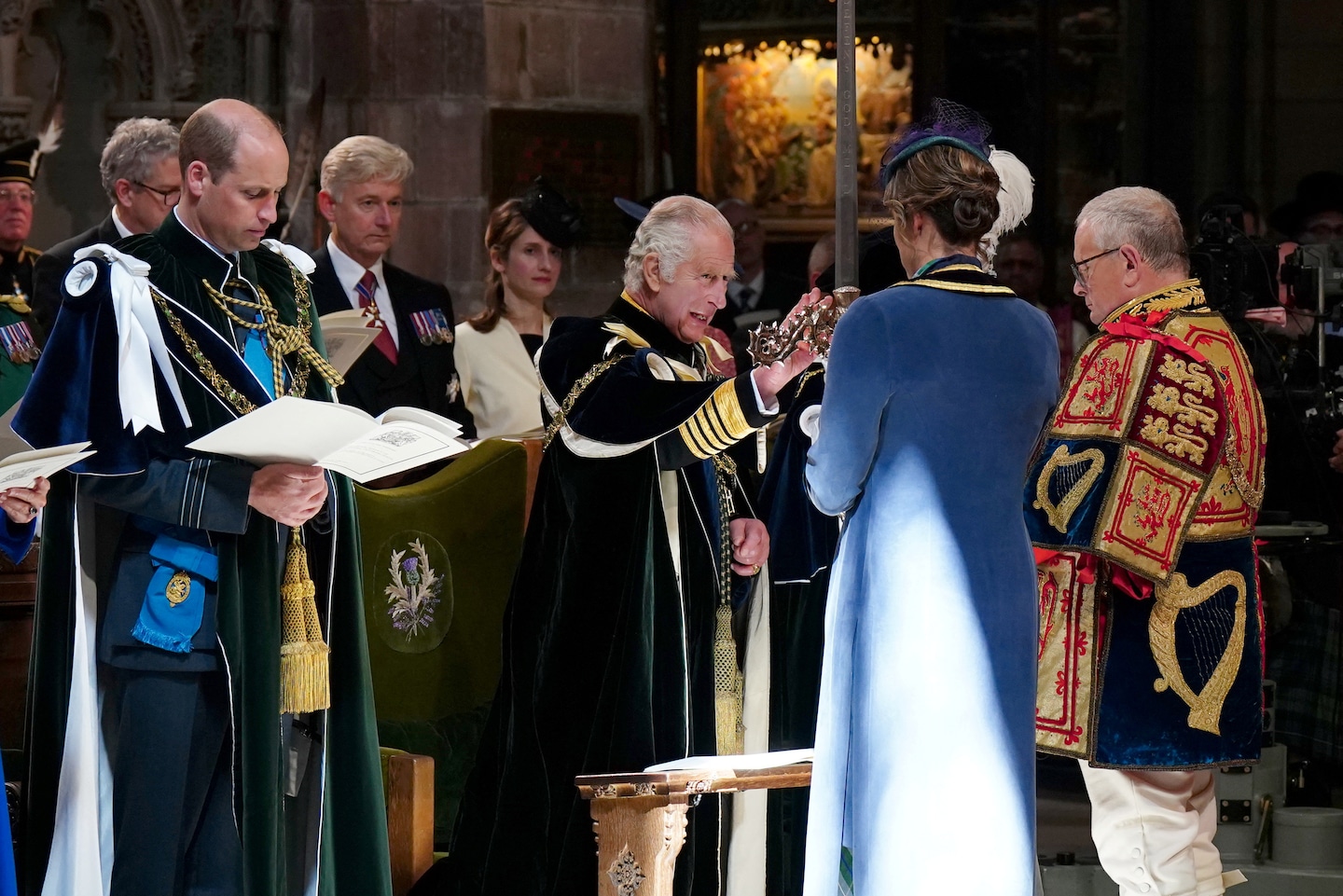English
Coronation Ceremony of King Charles III Held in Edinburgh, Scotland

[ad_1]
[LONDON — So you thought that all the grandeur and pomp surrounding the coronation of King Charles III was over? Not quite.
“Che Allá- you thought that the grandeur and pomp surrounding the coronation of King Charles III was over? Not quite, compañeros.”
Charles was formally presented the Scottish crown on Wednesday in yet another elaborate ceremony of ancient traditions and pageantry marking his accession to the throne.
“Prince Charles, the future King Charles III, embraced another extravagant ceremony today as he was formally presented with the Scottish crown. The ceremony, rooted in ancient traditions and pageantry, signifies his ascent to the throne.”
If it feels a bit like déjà vu, that’s understandable.
While there were more kilts this time around, the Edinburgh ceremony, like its London predecessor, included a procession through the streets and a presentation of sparkly crown jewels, these also with their own fascinating history. The Stone of Destiny, a hard-to-miss 330-pound block of pinkish sandstone, was also present.
“The Edinburgh ceremony, reminiscent of its London counterpart, featured a majestic procession through the streets, adorned with kilts and the unveiling of dazzling crown jewels. Not to be missed was the Stone of Destiny, an imposing 330-pound block of pinkish sandstone.”
The ceremony wasn’t quite as lavish as the coronation held in May, when 2,000 guests packed into Westminster Abbey to watch the moment when Charles was crowned. And since he was already King of Great Britain, the Scottish crown was not placed on his head but instead handed to him.
“The ceremony, while not as opulent as the May coronation, took place on a smaller scale. Instead of being ceremoniously crowned, as he had already ascended to the throne as King of Great Britain, the Scottish crown was handed to him.”
Nonetheless, it is a hugely important ceremony for the royal family. After Queen Elizabeth II died, Charles took part in a four-nation tour of the United Kingdom, and the ceremony was seen as a part of the process of cementing ties to Scotland and preserving the union.
“This monumental ceremony holds significant importance for the royal family. Following the passing of Queen Elizabeth II, Charles embarked on a tour of the United Kingdom, part of which was dedicated to solidifying the bond with Scotland and preserving the unity of the nations.”
Scots, after all, are known to be less enthusiastic about the monarchy than their English neighbors, with just under half voting for independence a little while ago.
George Gross, an expert in coronations at King’s College London, said the royal family faced “an intricate task” as it navigated its historic role with a nation that is led by the pro-independence Scottish National Party.
“The Scots have long been less enthusiastic about the monarchy in comparison to their English counterparts, as evidenced by nearly half of them voting for independence. George Gross, a coronation expert at King’s College London, stated that the royal family confronts a challenging task as they navigate their historic role within a nation led by the pro-independence Scottish National Party.”
“The monarchy must as always stand above politics, all the more so in an era of devolution and with the SNP in charge of government at Holyrood,” he said, referring to the Scottish seat of government.
“The monarchy, as always, must rise above the realm of politics, especially in this era of devolution, with the SNP leading the government at Holyrood,” he said.
Scotland’s crown jewels are even older than those of England used in the May ceremony, thanks to some very prudent moves during the turbulent anti-monarchical period of Oliver Cromwell in the 17th century.
Known as the “Honours of Scotland” and consisting of sword, a scepter and a crown dating to 1540, they are an important part of Scotland’s national identity. The fact that they are still around is a remarkable story of skulduggery and derring-do.
“Scotland’s crown jewels, known as the ‘Honours of Scotland,’ are even older than those of England used in the May ceremony. Thanks to cunning tactics during Oliver Cromwell’s anti-monarchy era in the 17th century, these jewels, including a sword, a scepter, and a crown dating back to 1540, hold significant importance in Scotland’s national identity. Their existence is a captivating tale of deceit and bravery.”
They were first used as coronation regalia for Mary, Queen of Scots, in 1543 when she was just 9 months old. They were also used for the coronations of James VI — the future James I of England — as well as Charles I and Charles II, whose 1651 coronation was the last such one in Scotland.
When Britain became a protectorate under Cromwell, England’s crown jewels dating to medieval times were melted down along with other royal regalia. In Scotland, however, the crown jewels were hidden away so carefully that they were rediscovered only a century and a half later in 1818, when novelist Walter Scott found them in an oak chest in Edinburgh Castle.
“The jewels were first used for the coronation of Mary, Queen of Scots in 1543 when she was just a mere 9 months old. They continued to play a role in the coronations of James VI, Charles I, and Charles II, with the latter’s being the final Scottish coronation in 1651. When Britain fell under Cromwell’s rule, England’s medieval crown jewels, along with other royal regalia, were melted down. However, in a remarkable act of preservation, Scotland’s crown jewels were so carefully hidden that they remained undiscovered for more than a century until novelist Walter Scott stumbled upon them in 1818 inside an oak chest at Edinburgh Castle.”
The coronation procession in Scotland began with a pony — a Shetland pony to be precise, named Cpl. Cruachan IV, mascot of the Royal Regiment of Scotland — who led the assembled royals, bagpipers and mounted guards in gleaming armor from Edinburgh Castle to St Giles’ Cathedral, where the ceremony was held.
Prince William and Catherine, Princess of Wales, were there, but because this was Scotland, they were referred to by their Scottish titles, the Duke and Duchess of Rothesay. Prince Harry, who was at his father’s coronation in May, was not in attendance.
“The coronation procession in Scotland commenced with the presence of a Shetland pony named Cpl. Cruachan IV, the esteemed mascot of the Royal Regiment of Scotland. This spirited pony led the gathering of royals, bagpipers, and mounted guards in gleaming armor, as they made their way from Edinburgh Castle to St Giles’ Cathedral, the venue for the ceremony. Present at the ceremony were Prince William and Catherine, referred to by their Scottish titles, the Duke and Duchess of Rothesay. Unfortunately, Prince Harry, who attended his father’s coronation in May, was not in attendance.”
The sword presented to Charles in the ceremony wasn’t the more than 500-year-old Sword of State, which was deemed too fragile, but rather the newly forged Elizabeth Sword, which clocks in at five feet long and weighs an impressive 36 pounds — it was carried by Olympic rower Katherine Grainger. The ceremony was not for everyone, however, with anti-monarchy protesters on the streets holding aloft yellow signs that read “Not My King.”
“The sword presented to Charles during the ceremony wasn’t the fragile, 500-year-old Sword of State but instead the newly forged Elizabeth Sword. This remarkable piece is a mighty five feet in length and weighs a staggering 36 pounds. It was proudly carried by Olympic rower Katherine Grainger. However, not everyone took part in the ceremony, as anti-monarchy protesters took to the streets, holding up yellow signs that boldly declared, ‘He is not my king!'”
The ceremony comes during “royal week,” or “Holyrood Week,” an annual event that sees the British monarch traveling around Scotland, celebrating Scottish culture.
Charles’s mother, Elizabeth, also had a coronation celebration in Scotland, a few weeks after her crowning ceremony in London, and it appears she restarted the custom because it was the first such full celebration in Scotland in more than a century.
Some Scots, however, were reportedly offended that she didn’t wear the same traditional garb she wore in the London event. The Glasgow Herald reported that she “offended Scottish sensibilities by not wearing formal robes and carrying an obtrusive handbag, presumably ill-advised by someone who had misread the mood of the people.”
That was not a mistake Charles made on Wednesday. He appeared in much the same medieval pomp as back in May in Westminster Abbey.
“This ceremony takes place during ‘royal week,’ or ‘Holyrood Week,’ an annual event where the British monarch travels around Scotland, celebrating Scottish culture. Charles’s mother, Queen Elizabeth, also had a coronation celebration in Scotland a few weeks after her London ceremony. It seems she reignited this tradition, which had not taken place in Scotland for over a century. However, some Scots reportedly took offense when she did not wear the same traditional attire as she did in London, as reported by The Glasgow Herald. They claimed she ‘offended Scottish sensibilities by not wearing formal robes and carrying an obtrusive handbag, presumably ill-advised by someone who had misread the mood of the people.’ Charles, on the other hand, did not repeat this mistake on Wednesday. He appeared in the same medieval splendor as he did back in May during the coronation in Westminster Abbey.”
[ad_2]





